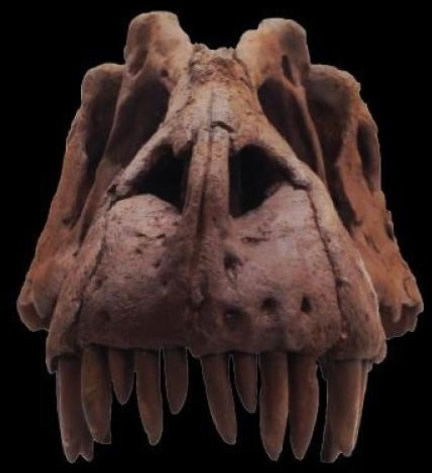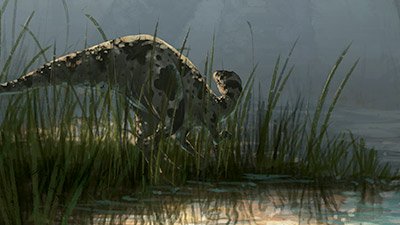
New Tyrannosaur Pushes Back Evolutionary Timeline
Remarkably advanced tyrannosaur too low on the evolutionary staircase complicates dinosaur lineage.
News Source
The newest named member of the tyrannosaur family tree is leading evolutionary paleontologists to redraw the map of how tyrannosaurs evolved. Unearthed in 2009 from the Upper Cretaceous portion of southern Utah’s Grand Staircase in the Wahweap Formation, conventionally dated at about 80 million years, the new tyrannosaur species has been dubbed Lythronax argestes. Lythronax earned its moniker meaning “king of gore” by possessing the same sort of skull anatomy that many paleontologists believe made Tyrannosaurus rex a “dinosaur king,” but 10 to 12 million years before T. rex evolved.
Head for Hunting
The back of Lythronax argestes’s head was wide, and it had a short narrow snout and somewhat forward-facing eyes. “The width of the back of the skull of Lythronax allowed it to see with an overlapping field of view—giving it the binocular vision—very useful for a predator and a condition we associate with T. rex,” explains the PLOS ONE report’s lead author Mark Loewen. “That skull is designed for grabbing something, shaking it to death and tearing it apart,”1 he says, noting that at an estimated 24 feet in length and 8 feet tall at the hips this tyrannosaur species was a little smaller than but quite similar to T.rex.

This is the reconstructed skull of Lythronax argestes, a newly named species of tyrannosaur. Paleontologists think it would have been about 24 feet long and stood 8 feet tall at the hip, based on the size of the bones that were recovered. Found in southern Utah’s Grand Staircase-Escalante National Monument, conventional millions-of-years dating would place this so-called “king of gore” too early in the evolutionary timeline, which must be redrawn to make it fit. Image by Mark Loewen, NHMU, via ScienceDaily.
No Downy Fluff
Loewen told reporters that Lythronax was covered in scales and feathers.2 However, nowhere in the fourteen page PLOS ONE report do the authors mention this finding. In addition to the skull, a few additional postcranial bones were found—a rib, a portion of the pelvis, and a few leg and foot bones. They do not report finding any fossilized integument or evidence that the tyrannosaur was covered in feathers or even the filaments, or “dinofuzz” that paleontologists eager to promote the notion that dinosaurs evolved into birds are fond of passing off as evolving feathers. Curious it is that such a dramatic discovery would go unmentioned in a paper reporting four years of analysis of the “holotype” of a newly discovered species. As we’ve said before, many evolutionists who insist without proof that dinosaurs evolved into birds interpret any sort of filament as an evolving primordial feather, and classify some fossilized extinct birds with obvious feathers as dinosaurs. In fact, the only justification given for such a definitive statement was in the interview with FOX, where University of Utah paleontologist Randall Irmis, a coauthor of the PLOS study, said, “Based on fossils found elsewhere, we now [sic] that a lot of tyrannosaurs had something of a downy covering -- protofeathers.”3
Land-Out-Of-Time
Prior to this discovery, evolutionary paleontologists believed Lythronax’s skull configuration was an advanced specialization that didn’t evolve until about 70 million years ago. They also thought it evolved in a tyrannosaurid in the more northerly portion of western North America’s Grand Staircase. Lythronax argestes was found too far south to fit into this evolutionary scenario, as memorialized in its species name argestes recalling Homer’s southwestern wind.
Fossils like Lythronax found in the American Southwest resemble those found farther north but differ at the species level. Explaining the existence of Lythronax’s advanced features predating its northern neighbors by millions of years complicates the transitional tale.
Loewen explained at a press conference that Lythronax at 80 million years of age was among the first of the famous tyrannosaurids to emerge but is so advanced in its anatomy that it looks like one of the latest tyrannosaurids to evolve.4 The researchers describing Lythronax do not suggest it was ancestral to T. rex but rather that both shared a common ancestor even more ancient. Such a scenario begs the question of what common ancestor these different twigs on the dinosaur family tree branched off of as well as what prompted them to evolve similar features along separate paths.
“Lythronax and other tyrannosaurids diversified between 95–80 million years ago, during a time when North America's interior sea was at its widest extent,” explains co-author Randall Irmis. “The incursion of the seaway onto large parts of low-lying Laramidia would have separated small areas of land from each other, allowing different species of dinosaurs to evolve in isolation on different parts of the landmass.”
Grand Evolutionary Staircase?
The paleontologists hope the region where they found the “king of gore” will provide many more examples of speciation prompted by the isolation they attribute to a rising sea level millions of years ago. “Grand Staircase-Escalante National Monument is the last great, largely unexplored dinosaur boneyard in the lower 48 states,” says co-author Scott Sampson. And co-author Philip Currie adds, “Lythronax is a wonderful example of just how much more we have to learn about with world of dinosaurs. Many more exciting fossils await discovery in Grand Staircase-Escalante National Monument.”

This detailed illustration from Answers magazine shows the Grand Staircase. The Kaiparowits Formation at the top of the Mesozoic strata sequence is conventionally dated about 10 million years later than the underlying Wahweap Formation (not labeled here but locally found around Lake Powell) where Lythronax argestes was found. From the evolutionary point of view, then the Wahweap Formation could be thought of as a land-out-of-time, as Lythronax apparently bumped its way to the head of the evolutionary line and developed advanced features before evolutionists thought they existed. Image: A. Snelling, “Order in the Fossil Record.” Click the picture to view a larger, pdf version.
Laramidia is a landmass that evolutionary scientists believe occupied the western portion of North America millions of years ago, cut off from the rest of continent by the Western Interior Seaway. Such a continent-like island would, they believe, have isolated groups of evolving animals allowing their development to proceed independently of others in the world and producing somewhat unique variations and species of animals found elsewhere in the world’s fossil record at the same time. They believe such an isolated landmass must have existed to explain why fossils found in it differ somewhat from those found elsewhere.
The tyrannosaur family tree, for instance, has up to now presumed that evolving dinosaurs with advanced specializations trekked across the Bering Strait to populate Asia. The presence of similarly advanced specializations far to the south 10 million years earlier demands the existence of a hitherto yet-undiscovered common ancestor much earlier in the timeline and even dictates that sea levels must have risen and fallen at certain requisite times to allow the animals to evolve, diversify, and disperse.5
When the iconic “Late” Cretaceous dinosaurs of the American West are stripped of the demand to explain their existence at the same time as their Asian cousins through evolution, it actually becomes quite easy to explain worldwide dinosaur diversity. Much of the fossil record is a record of the order in which creatures and habitats were catastrophically buried during the global Flood described in Genesis chapters 6 through 9. Massive fossil graveyards and layers of fossils formed nearly 4,500 years ago through catastrophic burial are not the record of evolving forms of life but of sudden death in a worldwide catastrophe that remodeled the earth.
The Noahic Flood buried billions of animals, preserving many as fossils. But the violent rising waters of the Flood did not instantaneously appear on the earth. The Bible indicates those waters rose for weeks and ultimately prevailed over the whole surface of the earth, the result, many Bible-believing Flood geologists note, of not just rain but also earthquakes and volcanic activity that opened “the fountains of the deep” (Genesis 7:11). Surging water levels and huge tsunamis would have overwhelmed habitats and ecosystems and buried their inhabitants in such a way as to create the sort of order we see in much of the fossil record. But these fluctuating water levels would also have temporarily isolated sections of land where some animals could have found a brief refuge, ultimately being overwhelmed to produce more layers of fossils that evolutionary paleontologists now interpret as landmasses isolated for millions of years.
Answers in Genesis geologist Dr. Andrew Snelling explains:
Their idea of an island in the middle of a surrounding sea assumes millions of years. During the Flood the “island” represented land temporarily exposed and on which many creatures found temporary respite before being buried or washed away by the next surge of rising Flood waters. Their concept of the seaway acknowledges that the ocean waters were rising to cover the continent.
The Grand Staircase is a massive geologic formation continuing northward from the Grand Canyon. In its successive layers the patterns in which creatures were buried records the order of their burial during the global Flood. Commenting on the region of the Grand Staircase where Lythronax was found—Utah’s Wahweap Formation—Dr. Snelling says:
The Kaiparowits Formation is near the top of the strata sequence in the Grand Staircase of southern Utah and consists primarily of sandstone, with subordinate mudstone. It is 2,800 feet thick. Fossils present in it include sharks and rays, fish (gars, bowfin and sturgeons), frogs and salamanders, turtles, lizards and crocodiles, as well as mammals, and not just the more well-publicized dinosaurs. It is claimed to have been the result of deposition of sediments in a fluvial environment. The underlying Wahweap Formation, where Lythronax argestes was found, consists of siltstone and similarly hosts dinosaur fossils, but also fossil mollusks found in shell beds with associated fossilized crabs, and numerous gastropod fossils.
Not only is this an interesting mix of fossils, but some of the dinosaurs have been exceptionally well-preserved with bones still articulated. Rivers are not known for burying such large creatures whole in sediments that also contain shell beds on such a wide scale over such a large area as covered by these massive sedimentary layers, at least not rivers under normal flow conditions. Rather, such deposition that results in the rapid burial of large creatures intact such as these dinosaurs requires flood conditions. And if flood conditions were on such a large scale over such a wide area depositing these thick sedimentary layers, then such conditions are consistent with the biblical global Flood cataclysm.
In fact, these two sedimentary formations are just a relatively small part of Colorado Plateau-wide 15,000 feet thick continuously deposited sequence of fossil-bearing sedimentary layers that begins at the bottom of the Grand Canyon in northern Arizona and once covered more than 250,000 square miles in four states up to the top of Bryce Canyon in Utah. Flood geologists are convinced this strata sequence was all deposited within the first five months of the biblical global Flood cataclysm.
God created all kinds of animals, including tyrannosaurs, about 6,000 years ago. He designed them to reproduce and vary within their created kinds. Dinosaurs did not evolve after millions of years of evolution but appeared on one day, the sixth day of Creation week, spoken into existence by the word of God. In fact, nothing observed in biology reveals either the emergence of life from non-living elements or the molecules-to-man/diatoms-to-dinosaurs evolution required to explain the existence of life without God. What we actually observe in biology and see preserved in the fossil record is consistent with what we read in the Creation account and the Flood account in the Bible’s opening chapters in Genesis, a historical record provided by the only living eyewitness to those events, our Creator God.
Further Reading
- T. rex—Fashioned To Be Fearless
- What Really Happened to the Dinosaurs?
- Geologic Evidences for the Genesis Flood
- Order in the Fossil Record
- Doesn’t the Order of Fossils in the Rock Record Favor Long Ages?
- Dinosaur National Monument in Utah
- Polar Dinosaurs
- The Extinction of the Dinosaurs
For More Information: Get Answers
Remember, if you see a news story that might merit some attention, let us know about it! (Note: if the story originates from the Associated Press, FOX News, MSNBC, the New York Times, or another major national media outlet, we will most likely have already heard about it.) And thanks to all of our readers who have submitted great news tips to us. If you didn’t catch all the latest News to Know, why not take a look to see what you’ve missed?
(Please note that links will take you directly to the source. Answers in Genesis is not responsible for content on the websites to which we refer. For more information, please see our Privacy Policy.)
Footnotes
- “New Tyrannosaur that Predates the Tyrannosaurus-rex Discovered in Southern Utah,” FOX News, November 7, 2013, http://www.foxnews.com/science/2013/11/07/new-tyrannosaur-that-predates-tyrannosaurus-rex-discovered-in-southern-utah.html.
- Ibid.
- Ibid.
- “All Hail the ‘Gore King’,” National Geographic, November 6, 2013, http://phenomena.nationalgeographic.com/2013/11/06/all-hail-the-gore-king.
- Mark A. Loewen et al., “Tyrant Dinosaur Evolution Tracks the Rise and Fall of Late Cretaceous Oceans,” PLoS ONE 8, no. 11 (November 6, 2013): e79420, doi:10.1371/journal.pone.0079420.
Recommended Resources

Answers in Genesis is an apologetics ministry, dedicated to helping Christians defend their faith and proclaim the good news of Jesus Christ.
- Customer Service 800.778.3390
- Available Monday–Friday | 9 AM–5 PM ET
- © 2025 Answers in Genesis





